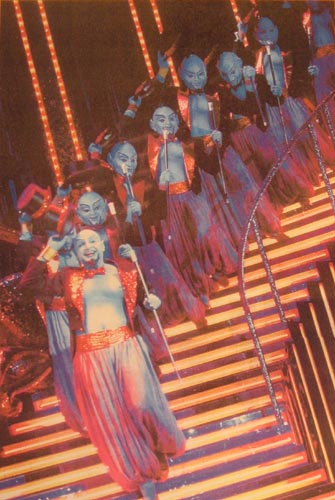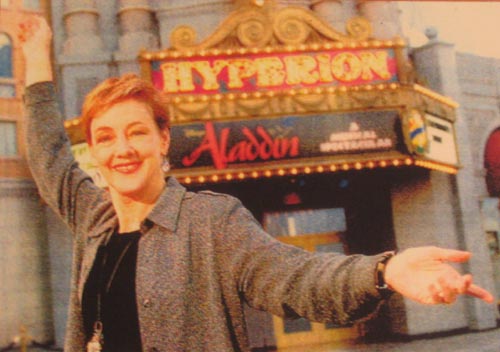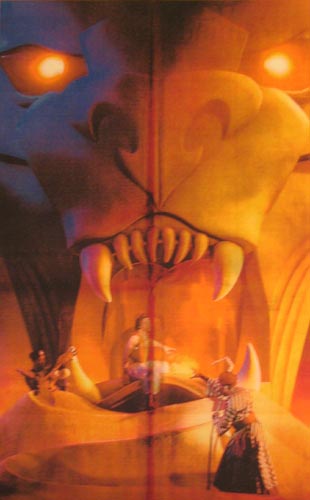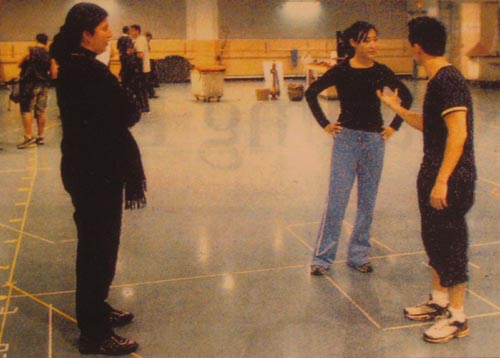Granting Disney's Wish

DAZZLING DISPLAY: Nick Santa Maria leads a line of genies in top hats and tails in "Disney's Aladdin - A Musical Spectacular." Says Santa Maria, "The little kids are going to enjoy the big blue genie, the visuals, the funny faces, the noise. I'm going to be aiming my barbs at the parents."
Source: Los Angeles Times, January 5, 2003, Calendar Part II, p. 39
Three creative forces team up on 'Aladdin' with the goal of redefining theme park shows.
By Mike Boehm Times Staff Writer
Anne Hamburger knows how to play the Pied Piper.
Once she stood in a housing project on Manhattan's West Side, shouting at the top of her lungs that she needed workers and was willing to pay. Soon she was marching a troop of about 30 youngsters to an abandoned pier on the Hudson River.
There, for minimum wage, they built a fence she needed as part of her marginally funded but artistically ambitious vision of staging avant-garde theater in some of New York's most decayed and derelict places.
Now, a decade later and a continent away, she is doing it again. Only this time she is marching through the back lot of the Happiest Place on Earth, and the duckling trail of about 20 people behind her consists mainly of the folks who run Disneyland. The parade begins at Team Disney, the management center whose high-vaulting lobby, painted in swirls of red and black, makes you feel as if you're standing at the bottom of a strawberry-chocolate parfait. It ends nearby, in a hangar-like rehearsal hall the size of a high school gym.
Without doffing her long, black, woolly frock coat, Hamburger picks up a microphone and plays the emcee for Disneyland President Cynthia Harriss and her staff of marketers, publicists and merchandisers, the functionaries charged with selling what Hamburger has wrought. It's early November, and "Disney's Aladdin -- A Musical Spectacular" is still more than two months from its Jan. 17 opening after a month of previews.
This rehearsal run-through will let the Disney team see for the first time what new manner of beast -- Broadway goes to the theme park -- it has on its hands.
"We're glad to let you in on the process of making this happen," Hamburger says.
The home-team audience proceeds to laugh, to cheer, to be utterly slain -- even though scenery, props and costumes are minimal and the big special effects are still being put together at Disney's California Adventure, where the show will play three or four times daily in the 2,000-seat Hyperion Theater.
Yes, it's a big world after all for Hamburger, a personable, confident woman whose quirks include pronouncing her first name "Annie" while continuing to spell it "Anne." At 49, this erstwhile Cinderella of the fringes rules a corporate palace as the executive vice president of creative entertainment for Disney's worldwide theme park operations. "Aladdin," a 40-minute stage musical adapted from the popular cartoon feature, is her first major production.
Harriss won't discuss the budget, other than to say the investment is "significant" and "long-term," with hopes that "Aladdin" can become one of the park's signature attractions, pulling in crowds for many years. The show calls for 18 scene changes and 250 costumes for a cast of 50 covering the show's 29 roles. Among the sights: a life-size model elephant lumbering through the audience like a visitor from "The Lion King," and a flying carpet that soars not only back and forth but from side to side while seeming to bank into its turns. There also is a little lamp from which billows a very large genie.

LOOKING AHEAD: Once part of the avant-garde and now a Disney executive, Anne Hamburger says she sees the next years of her professional life as family-oriented and populist.
With Disney granting her wish for a high-profile creative team, Hamburger hired a leading grand opera director, Francesca Zambello, to oversee "Aladdin" between engagements at the Bastille Opera in Paris and New York's Metropolitan Opera. Hamburger and Zambello -- a recent recipient of one of France's highest cultural awards, the Chevalier de I'Ordre des Arts et des Lettres
-- then picked Lynne Taylor-Corbett as choreographer. Taylor-Corbett's credits include creating the theatrical hit "Swing," choreographing the film "Footloose" and devising dances for the American Ballet Theatre and Alvin Ailey American Dance Theater.
For Hamburger's corporate bosses at Disney, the ultimate point of her mission is to help turn a pumpkin into a cash cow. Disney's theme parks have fared poorly amid the tourism-dampening international economic woes and post-Sept. 11 global anxiety; California Adventure, in particular, has failed to draw as expected. When it opened two years ago, it was quickly tagged as a place too bent on seeming hip and too little concerned with Disney's bread-and-butter audience of families. Along with other new attractions, "Aladdin," which is included in the regular park admission, is being counted on to help change that perception.
Hamburger and her team are here because Disney wants to replicate in the theme parks a formula that has paid dividends for another division: Disney Theatricals, which produces the company's Broadway shows. Take a beloved Disney property ("The Lion King"), turn it over to an accomplished avant-garde stage artist with a distinctive visual flair (director Julie Taymor), and reap critical kudos and huge profits.

MAGICAL SCENERY: Iago (Ron Butler), left, Aladdin (Miles Wesley) and Jafar (Lance Roberts). Major roles are double-cast due to multiple performances each day, seven days a week.
"In a lot of ways, 'The Lion King' was the model," says Paul Pressler, the former Disney theme-parks division chief who hired Hamburger away from La Jolla Playhouse, where she served as artistic director for a single season in 1999-2000. "I thought Anne would have the same capability -- to blend the big, spectacular Disney quality with a much higher-brow creative talent level," Pressler, who recently left to run the clothing retailer Gap Inc., says live shows with the Disney stamp give the company's theme parks a competitive advantage over rivals -- and corporate leaders want to keep it that way by "raising the bar aesthetically on our productions."

ONCE MORE, WITH FEELING: In rehearsal, director Francesca Zambello, left, works out the emotions in a scene between Elizabeth Young, as Jasmine, and Michael K. Lee, as Aladdin.
Hamburger's job, he says, is "to be the puppeteer ... the one who's pulling the talent together."
"When I interviewed her," Pressler says, "I asked what her favorite Disney character was. I think her answer was Snow White, and she was gushing about the story and the characters. Some people, particularly when they're a highbrow artistic person, kind of look at you cross-eyed and can't give you an answer. I saw she understood the Disney aesthetic. I offered her the job on the spot."
Super-size art, tiny budget
Until that day, Hamburger had spent most of her career trying to think big even when her niche as a producer of avant-garde theater compelled her to spend small.
As an undergraduate sculpture major at the University of Massachusetts, she created a life-size outline of a towering library building, laid out on the ground near the actual structure. She wanted to jolt people out of automatic pilot with an intrusion of super-size art in the paths of their daily scurrying. Hamburger persuaded the architecture department to help her with the drafting, and the athletic department to chalk in the design -- all free of charge.
From 1986 to 1999, she made her name as the founder and leader of En Garde Arts, a nonprofit New York City theater company devoted to putting on plays in settings where other producers wouldn't think - let alone dare - to tread. A modern updating of the ancient Greek tragedy "Orestes," on a rusted, crumbling pier jutting into the Hudson River. Samuel Beckett's "Krapp's Last Tape" played out on a dirt floor in a vacant office space in Brooklyn. An adaptation on "The Brothers Karamasov" performed on the cobblestone streets of lower Manhattan's meatpacking district. The plays in these marginal places often were socially conscious works about marginal people. Among Hamburger's fondest En Garde memories: a lovely waterfall springing from the roof of the fortress-like former nursing home that was the site of "Another Person Is a Foreign Country," a play by Charles L. Mee about the dignity of disabled folks. As the water cascaded, a blind choir sang.

COILS: Lynne Taylor-Corbett wrestles with ideas for a fight ballet with a puppet snake.
Hamburger says she achieved that vision with just a fire hose and some piping with holes in it. "At the exact right moment, the production manager ran around the corner and turned on the fire hydrant," she said. "It was a beautiful, touching moment, and the whole effect cost, like, $80."
In the coils of a snake
A quote from Walt Disney hangs over the entrance to the rehearsal and production hall on Disneyland's back lot: "It's kind of fun to do the impossible." Inside, Taylor-Corbett and her charges are facing a challenge that may not be impossible but that could be unique for a stage musical.
It's the climactic confrontation of "Aladdin." The villainous sorcerer, Jafar, has turned himself into a gigantic serpent, and its tail section is putting the squeeze on our hero. The more he struggles, the more entangled he becomes.
"Ooof," grunts actor Michael K. Lee as the tip of the tail thuds against the floor, bounces and pops him in the nose. The 30-foot-long tail is being operated by a handler who throws it from the wings and a puppeteer who makes it thrash and curl by turning a metal crank.
Taylor-Corbett, soft-voiced and exuding patience, has to figure out how to choreograph this stage fight between man and device. She tries to break it down into discrete movements, calling out the steps in the time-honored fashion of dance makers. But instead of something familiar like "turn, step, step, kick," she is intoning, "Throw, crank, crank, stop." She needs a vivid-looking tangle between Aladdin and the yellow-bellied, diamondback monster. For that to happen reliably, she decides, the machinery must pause for an imperceptible moment so the actor can grab it, control it and start to spin into a reptilian embrace.
Now Miles Wesley takes his turn -- he's the other Aladdin in a show in which all the major roles are double-cast because there are multiple performances each day, seven days a week. Taylor-Corbett does a demonstration duet with the snake tail, and he tries to replicate her steps.
"There you go," she says. But the cheer gives way to "whoops!" when a snake coil accidentally flips over the actor's head like a hula hoop. There will be many more repetitions as they try to sort this out.
"I'm trying to get a formula," Taylor-Corbett tells her two athletic Aladdins. "I'm sort of nervous. I just don't want you to get smashed." As it turns out, the formula will prove elusive. Zambello eventually decides the payoff in a snake-coil ballet isn't worth the risks, and that Aladdin will nimbly leapfrog the monster's tail instead of being coiled in its clutches. "We never got it to work consistently," Taylor-Corbett later laments. "And when it didn't work, it looked so bad. It was frustrating. Just prop hell."
Concocting a visual feast
Hamburger turned to Zambello because she wanted a master of spectacle in charge. Too many directors, Hamburger thinks, have a kind of tunnel vision -- concentrating on bringing the spoken word to life, but giving short shrift to movement and the pictorial possibilities of the stage. She hadn't seen a Zambello opera but hired her based on reputation and the visual feasts she saw in still shots from the director's 20-year career.
But even a show that promises lavish sights must attend to the small, human details.
During an afternoon rehearsal, Zambello, a tall, no-nonsense woman clad in black except for white athletic socks and a purple scarf, is turning an intent gaze on the disguised Aladdin's courtship of the princess Jasmine. No props or special effects here. It's the same old story, a fight for love and glory, and the fundamental things apply: Boy loves girl, girl scorns boy (thinking he's just another in an endless succession of stuck-up suitors), boy plays his last trump card by offering a whirl on a flying carpet.
The emotional temperature shifts rapidly as Lee and Elizabeth Young enact the play's pivotal romantic tete-a-tete. Zambello wants Jasmine's enchantment to show through her ire.
"Liz, when you're saying 'no,' I have to feel like you're saying 'yes,' " the director says.
They play the scene again, and Jasmine's steely tone dissolves into breathy wonderment, revealing a woman charmed.
Zambello, who addresses her actors as "guys," nods from her chair and murmurs to herself: "Good."
Nick Santa Maria, who plays the genie, wasn't sure what to expect of Zambello when he signed on. "I was concerned," says the 40-year-old actor-comedian, an off-Broadway veteran who is one of the senior members of a mostly twenty-something cast. "When you think of grand opera, you think of nothing but spectacle. Comedy is full of nuance. I was concerned she wouldn't have the experience of dealing with multiple layers."
Instead, Santa Maria says, he benefited "immeasurably" from Zambello's pointers on comic timing. She gave the actors playing the genie and the script's other comic character, Jafar's parrot henchman, Iago, leeway to improvise their own jokes in a performance that uses the film's songs but not its dialogue. Santa Maria responded with a bevy of contemporary popculture references and quick impressions of famous entertainers. His genie interpretation is akin to -- but calculated to avoid copying -- what Robin Williams brought to the role in the "Aladdin" film.
"The little kids are going to enjoy the big blue genie, the visuals, the funny faces, the noise," he says. "I'm going to be aiming my barbs at the parents, so there'll be something for everybody."
Proselytizing for the theater
The idea that everybody comes to Disneyland -- or at least a much closer approximation of "everybody" than you'll get in theaters large or small, mainstream or avant-garde -- is an important motivator for the creative troika of "Aladdin." Gathered around a white plastic table on a commissary patio during a break in rehearsals, Hamburger, Zambello and Taylor-Corbett don't take long to bring up what they hope will be the ultimate payoff of this show: not just the bolstering of a theme park's revenue, but the incubation of new audiences for all forms of live stagecraft.
"We're sort of evangelists of the theater, people who believe so strongly in the power of live theater that we haven't gone in other directions," Zambello says. She worked for Disney three previous times since 1999, staging workshops of proposed shows for the Euro Disney theme park near Paris and the company's Broadway division -- but those failed to get a green light. "I'm interested in things that speak to a much wider-ranging audience, a new audience, a young audience. In my heart I'm a populist because I want everybody to love what I love."
Hamburger predicts far-reaching dividends from what the director leaves in Anaheim:
"Families and young children, day after day, will see a fantastic telling of 'Aladdin,' " she says. "Now, how can that help but turn them on to what the possibilities of theater are?"
"Enough of them sitting by their computers!" Zambello interjects theatrically, sounding as if she wishes she had a genie to put on the case.
One of Taylor-Corbett's tasks is to make the worlds of theater and theme park connect in a final bow that, like every other aspect of this compressed musical, wastes no time. She says Disney show veterans have told her there typically are no bows after theme park entertainments because when the crowd senses the story is over, the imperative is not applause, but making it to the next ride, the next corn dog, the next encounter with Mickey and Goofy.
"You're trying to train audiences for the future," the choreographer says. "A bow is a must in the theater tradition. It says that these were real people with skills doing this for you, and it should be acknowledged. We want to bring it to the theme park -- albeit quickly."
With "Aladdin" up and running, Zambello will occupy herself next with staging the sack of Troy and an assortment of onstage suicides for the Met's "Les Troyens." The Alvin Ailey company recently staged the premiere of Taylor-Corbett's new dance, "Prayers From the Edge," which deals with blood hatreds between tribes and is partly her response to horrors in the Middle East.
Hamburger, meanwhile, remains on the clock at Disney. Or, rather, on four of them. The décor in her living room-size office in Glendale includes four large wall clocks reporting the time in Orlando, Fla., Anaheim, Paris, and Tokyo, the sites of Disney's theme park operations. Four of the happiest places on Earth, where the confrontational methods and disturbing themes of the avant-garde she once inhabited must never intrude.
Mee, the idiosyncratic writer of "Big Love" who had three plays produced by Hamburger before she folded En Garde Arts, laments her departure from New York as "an immense loss" for its edgy theater scene. Nothing, he says, has replaced her knack for doing the unexpected on a huge scale. Yet he thinks taking her act to Disney made sense -- and not just because the burnout factor of running a nonprofit theater company on her own for more than a decade and the new financial imperatives Hamburger and Ralph Jenney, her philosopher husband, faced after she gave birth to twins five years ago.
"It's not a sellout or a compromise of artistic vision. It's not as if she wanted to produce Ibsen and now she sold out and has to do 'Aladdin,' " he says. "She always wanted to produce spectacle, things that had fabulous visual impact. For somebody who has that vision of the theater, to have more money to stage a spectacular event is terrific."
Hamburger's office sports proud trophies from her past: a photo from Mee's "Orestes" -- the play on the pier that required her to play Pied Piper to a work gang of young fence builders - - and the 1995 Edwin Booth Award plaque she won from City University of New York for sustained theatrical achievement. But she feels no twinge at leaving behind some of the darker adventures that made her reputation.
"I did so much murder and mayhem in New York, I don't need any more," she says with a chuckle. "That was the first 13 years of my professional theatrical life. The next 13 are kind of redemptive, family-oriented, optimistic, joyful, populist -- relevant. I used to be an avant-garde artist who was a closet sentimentalist. Now I've come out of the closet."
Back to the Main Page




